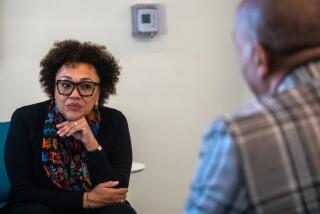CSUN to Honor Life of Folk Arts
- Share via
Lisa Richardson struggled for a moment to find the right words to describe the effect Bess Lomax Hawes has had on folk arts in the United States.
“Bess is probably the mother of any of us who do work in public folk arts,” said Richardson, who manages the year-old folk and traditional arts program for the Los Angeles County Arts Commission. “She’s like a Renaissance woman. She’s an educator, she’s a producer, she’s been an advocate for the arts her whole life. She’s really one of the most important people in the field.”
Today, the distinguished folklorist and scholar will be honored with a distinguished achievement award from Cal State Northridge.
Now 81 and living in Northridge, Hawes has been a force in American folk arts since she was a girl.
As a teenager, she worked with her father, John L. Lomax, and her brother, Alan, on their groundbreaking collection of American folk music, “Our Singing Country.” In the 1940s, she performed with Woody Guthrie, Pete Seeger and her late husband, Butch Hawes, as one of the Almanac Singers.
She co-wrote “Charlie on the MTA,” a hit for the Kingston Trio during the folk revival of the ‘50s and ‘60s.
The founding director of the folk and traditional arts program of the National Endowment for the Arts, Hawes in 1982 created the National Heritage Fellowships, which honor a dozen master folk artists each year, be they hula masters or Laotian weavers. She also helped establish apprenticeship programs designed to ensure that traditional arts survive.
“It’s hard to imagine a folk arts program at the federal level without her,” said Barry Bergey, director of Folk and Traditional Arts for the NEA. “She’s really the one who conceptualized it and made it happen.”
Hawes had seen the positive role government could play in promoting the arts during the Roosevelt era--and had also seen how quickly that support could disappear, Bergey said.
“She’s a good strategist,” Bergey said, in explaining how Hawes helped create durable federal, state, regional and local folk arts programs. “She had the Rolodex, but she also had the commitment to the artists and the art forms.”
Lomax received the National Medal of the Arts from President Clinton in 1993, along with director Billy Wilder, singer Ray Charles and writers William Styron and Arthur Miller.
In 2000, the NEA created the Bess Lomax Hawes Award, which honors people who make major contributions to folk and traditional arts.
“She was my first guitar teacher,” recalled Roz Larman of West Hills, co-host of “FolkScene” on public radio for more than 30 years.
Alan Lomax once joked that his sister taught the entire state of California to play the guitar--because she developed methods for teaching dozens of people at a time.
Hawes’ daughter, Naomi Bishop, director of liberal studies and an anthropology professor at CSUN, said, “Even now, years later, you can’t go anywhere without people coming up and saying, ‘I took guitar lessons from your mother.’”
Bishop recalled that having a beloved mother--and one ahead of her time--was sometimes trying. Hawes played the banjo, an instrument that made young Bishop cringe; other mothers played the guitar.
And Hawes once entertained Bishop’s Girl Scout troop with a rendition of “The Devil-Curst Wife.” The traditional song, which extols the superiority of women, includes mild profanity that upset one of Bishop’s fellow scouts.
“I was embarrassed,” Bishop said, although Hawes “was simply trying to raise our consciousness.”
The tribute to Hawes will take place at the CSUN Center for the Visual and Performing Arts at 7 p.m., before a performance by the Aman folk dance ensemble. Hawes taught folklore at the university.
The program will include traditional dance from five continents and pieces inspired by Lomax, including a performance by children from the Balboa Gifted/High Ability Magnet School, said Rose Anne Schoof, executive director of Aman.
Schoof said the troupe is using a grant from the California Arts Council to introduce elementary school children to folk music and dance from around the world.
Hawes, who plans to speak briefly at the tribute, once defined folk art as “an identifier ... a public statement of what a hell of a fine thing it is to be a Lithuanian or a Greek or a Comanche Indian
More to Read
The biggest entertainment stories
Get our big stories about Hollywood, film, television, music, arts, culture and more right in your inbox as soon as they publish.
You may occasionally receive promotional content from the Los Angeles Times.










